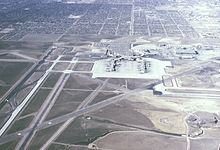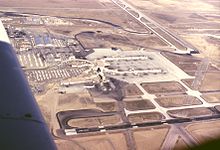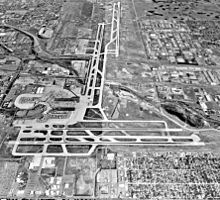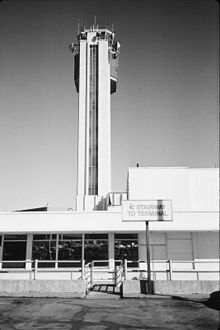Stapleton International Airport
Stapleton International Airport | |||||||||||||||||||||||||||||||
|---|---|---|---|---|---|---|---|---|---|---|---|---|---|---|---|---|---|---|---|---|---|---|---|---|---|---|---|---|---|---|---|
 Stapleton highlighted on a map of Denver neighborhoods | |||||||||||||||||||||||||||||||
| |||||||||||||||||||||||||||||||
| Summary | |||||||||||||||||||||||||||||||
| Airport type | Public, Defunct | ||||||||||||||||||||||||||||||
| Serves | Stapleton, Denver, Colorado, United States | ||||||||||||||||||||||||||||||
| Location | Stapleton, Denver, Colorado | ||||||||||||||||||||||||||||||
Hub for |
| ||||||||||||||||||||||||||||||
| Built | 1900 | ||||||||||||||||||||||||||||||
| In use | 1916 | ||||||||||||||||||||||||||||||
| Coordinates | 39°45′38.6″N 104°53′31.1″W / 39.760722°N 104.891972°W / 39.760722; -104.891972Coordinates: 39°45′38.6″N 104°53′31.1″W / 39.760722°N 104.891972°W / 39.760722; -104.891972 | ||||||||||||||||||||||||||||||
| Map | |||||||||||||||||||||||||||||||
 DEN Location within Colorado | |||||||||||||||||||||||||||||||
Runways | |||||||||||||||||||||||||||||||
| |||||||||||||||||||||||||||||||
Stapleton International Airport was the primary airport serving Denver, Colorado, United States from 1929 to 1995. At different times it served as a hub for Continental Airlines, the original Frontier Airlines, People Express, Trans World Airlines (TWA), United Airlines and Western Airlines. Other airlines with smaller hub operations at Stapleton included Aspen Airways, the current version of Frontier Airlines and Rocky Mountain Airways, with all three of these air carriers being based in Denver at the time.[1]
In 1995, Stapleton was replaced by Denver International Airport. It has since been decommissioned and the property redeveloped as a retail and residential neighborhood.
Contents
1 History
1.1 Prewar years (1929-1945)
1.2 Postwar years (1945-1978)
1.3 Post-deregulation years (1978-1985)
1.4 Decommissioning (1985-1995)
1.5 Post-closure redevelopment
2 Facilities
3 Accidents and incidents
4 References
5 External links
History

Looking west, January 1966. Only concourses A, B, and C existed then. A United Airlines Pilot Training Center was later built on the vacant land between the airport's west boundary and the housing tracts.

Looking north, January 1966. Runway 35 became 35L, after 35R was built. The old United Airlines pilot training center buildings, on the airport proper, were still in operation. A UAL DC-8 pilot training flight has just made a missed approach, complete with its shadow.
Prewar years (1929-1945)
Stapleton opened on October 17, 1929 as Denver Municipal Airport. The development of the airport was spearheaded by Denver mayor Benjamin F. Stapleton and Improvements and Parks Department manager Charles Vail.[2] Prior to the new airport's opening, Denver had been served by a number of smaller facilities, including an airstrip along Smith Road in Aurora (first used in 1911), an airfield at 26th Avenue and Oneida Street, Lowry Field near 38th Avenue and Dahlia Street, and Denver Union Airport at 46th Avenue east of Colorado Boulevard.[3]
In the late 1930s the airport facilities consisted of two hangars and a small administration building primarily used for air mail processing.[2][4]United Airlines and Continental Airlines began service in 1937.[2] The March 1939 Official Aviation Guide shows nine weekday departures: seven United and two Continental.[citation needed]
Continental moved its headquarters from El Paso to Denver in October 1937,[5] as airline president Robert F. Six believed that the airline should have its headquarters in a large city with a potential base of customers.[6] Continental later moved its headquarters to Los Angeles in July 1963.[7]
The airfield grew dramatically during World War II, more than doubling in physical area. It was renamed Stapleton Airfield in 1944, in honor of Mayor Stapleton.[2]
Postwar years (1945-1978)
Stapleton's modern horseshoe-shaped terminal design was first announced in 1946 and promptly shelved by incoming mayor James Newton. The original administration building was extended with new wings in the early 1950s, and replaced entirely in 1954.[2]
By the early 1950s, the airport was served by five major airlines. United connected Denver to both coasts, with multi-stop routes extending to Boston, New York and Washington in the east, to major cities on the West Coast, and to Honolulu.[8]Braniff operated routes from Denver to Texas, with connections to South America.[9] Continental connected Denver to El Paso, St. Louis and Tulsa.[10]Frontier operated northbound and southbound from Denver to the other mountain states.[11]Western connected Denver to Minneapolis and Edmonton.[12]
The April 1957 OAG shows 38 United, 12 Continental, seven Braniff, seven Frontier, seven Western, five TWA and one Central.[citation needed] The jet age arrived in May 1959 when Continental began operating Boeing 707 jetliners into Stapleton, initially under weight restrictions due to Stapleton's runway capacity.[2]
Runway 17/35 and a new terminal building opened in 1964.[citation needed] Although Stapleton officially adopted the "International" name in 1964, its first nonstop international service came in 1968, when Western began flights to Calgary.[3] The Boeing 747 was introduced to Stapleton on Continental's Los Angeles route in 1970.[3]
In the early 1970s, Frontier occupied Concourse A, United occupied most of Concourse B, and Western and Continental occupied most of Concourse C.[13] United and TWA served both coasts nonstop during this era, while Continental and Western's nonstop flights only extended to the western half of the country.[14] Concourse D was built in 1972.[citation needed]
Post-deregulation years (1978-1985)
After deregulation, Denver's four major incumbent airlines developed hubs at Stapleton.[15] United occupied Concourse B, Continental and Western occupied Concourse C and Frontier occupied Concourse D.[16] Western operated nonstop service between Denver and London from 1981 to 1982, but thereafter shifted resources to Salt Lake City and Los Angeles; Denver ceased to be a Western hub by the time Delta acquired Western in 1987.[17]Southwest Airlines and People Express tried low-cost service to Denver in the mid-1980s, but Southwest withdrew and People Express was acquired by Continental.[18]
In September 1982 the first revenue flight of the Boeing 767 arrived at Stapleton, a United flight from O'Hare International Airport in Chicago.[19]
During the energy boom of the early 1980s, several skyscrapers were built in downtown Denver, including Republic Plaza (Denver's tallest at 714′). Due to Stapleton's location 3 miles (4.8 km) east of downtown, the Federal Aviation Administration imposed a building height restriction of 700'-715' (depending on where the building was). This allowed an unimpeded glide slope for runways (8L/26R) and (8R/26L). The height restriction was lifted in 1995, well after the city's skyscrapers had been erected.[citation needed]
Decommissioning (1985-1995)

Two Convair 580s of the Denver-based Aspen Airways at Stapleton in 1986
By the 1980s, plans were under way to replace Stapleton with a new airport. Stapleton was plagued with a number of problems, including:
- inadequate separation between runways, leading to extremely long waits in bad weather
- little or no room for other airlines that proposed/wanted to use Stapleton for new destinations (an example of this was Southwest Airlines)
- a lawsuit over aircraft noise, brought by residents of the nearby Park Hill community
- legal threats by Adams County, to block a runway extension into Rocky Mountain Arsenal lands
The Colorado General Assembly brokered a deal in 1985 to annex a plot of land in Adams County into the city of Denver, and use that land to build a new airport. Adams County voters approved the plan in 1988, and Denver voters approved the plan in a 1989 referendum.

USGS aerial photo of Stapleton International Airport looking north, June 1993, shortly before its closure. Runway 17R/35L crosses Interstate 70 at its midpoint.
To combat congestion, runway 18/36 was added in the 1980s and the terminal was again expanded with the $250 million (or $58 million according to the New York Times[20]) 24 gate Concourse E opening in 1988, despite Denver's replacement airport already being under construction.[21][22][23] By the early 1990s, Concourses A and B were exclusively used by United and United Express, Continental used most of Concourses C and D, and most other airlines moved to Concourse E.[24] Continental closed its Stapleton pilot and flight attendant bases in October 1994, reducing operations and making United the airport's largest carrier.[25]
Delta Flight 569 from Dallas/Ft.Worth was the last commercial flight to land at Stapleton.[citation needed] On February 27, 1995, air traffic controller George Hosford, cleared the last plane – Continental Flight 34, a McDonnell Douglas DC-10 bound for London′s Gatwick Airport – to depart from Stapleton.[26][27] The airport was then shut down. A convoy of ground service equipment and other vehicles (rental cars, baggage carts, fuel trucks, etc.) traveled to the new Denver International Airport (DEN), which officially opened for all operations the following morning.[28]
Post-closure redevelopment

Control tower at Denver's Stapleton International Airport photographed from top level of close-in parking structure, 1995.

Former Stapleton International Airport from the air (6 February 2006)
When it closed in 1995, Stapleton had six runways (2 sets of 3 parallel runways) and five terminal concourses. The runways at Stapleton were then marked with large yellow "X"s, which indicated it was no longer legal or safe for any aircraft to land there. The IATA and ICAO airport codes of DEN and KDEN were then transferred to the new DIA, to coincide with the same changes in airline and ATC computers, to ensure that flights to Denver would land at the new DIA.[29]
While Denver International was being constructed, planners began to consider how the Stapleton site would be redeveloped. A private group of Denver civic leaders, the Stapleton Development Foundation, convened in 1990 and produced a master plan for the site in 1995, emphasizing a pedestrian-oriented design rather than the automobile-oriented designs found in many other planned developments.
Originally Denver sought tenants for Stapleton's terminal and concourses, but these buildings proved ill-suited for alternative uses. A July 1997 hailstorm punched roughly 4,000 holes in the roofs of the old terminal and concourses, causing severe water damage, which compelled the city to tear them down. However, the airport's 12-story control tower has been retained as part of the new Punch Bowl Social, a restaurant and social gathering spot. The office building attached to the tower houses the kitchens and social areas; the tower is closed to public access but is available for private tours.[30]
All of Stapleton's airport infrastructure has been removed, except for the former control tower. The final parking structure was torn down to make room for the "Central Park West" section of the housing development in May 2011.[citation needed]
D.I.A. still owns some land at the former Stapleton site, an open field area bordered by Central Park Blvd to the west, 40th Ave to the North, Havana St. to the East, and 37th Ave to the south, with the exception of the Coca-Cola and FedEx warehouses. The City's Department Of Aviation has continuously owned this site even after Stapleton was closed & decommissioned.[citation needed]
Facilities

UAL Douglas DC-6, N37514, code 5414, parked on the northwest maintenance ramp of Stapleton Airport, in September 1966.
At the time of its decommissioning, the airport covered 4,700 acres (19 km2.) and had the following runways:
- 17R/35L (11,500 ft) Runway Surface : Concrete
- 17L/35R (12,000 ft) Runway Surface : Concrete
- 8L/26R (8,599 ft) Runway Surface : Concrete
- 8R/26L (10,004 ft) Runway Surface : Concrete
- 7/25 (4,871 ft) Runway Surface : Concrete
- 18/36 (7,750 ft) Runway Surface : Asphalt
The terminal had five concourses:
- Concourse A – Commuter flights, Mesa Air Group, United Airlines
- Concourse B – United Airlines
- Concourse C – Continental Airlines, Frontier Airlines, Mexicana Airlines
- Concourse D – Continental Express, Delta Air Lines, MarkAir, Pan American World Airways, Trans World Airlines
- Concourse E – America West Airlines, American Airlines, Northwest Airlines, Sun Country, USAir
Accidents and incidents
Several major air crashes occurred at Stapleton:
- On November 1, 1955, United Airlines Flight 629, a Douglas DC-6B bound for Portland, Oregon, was blown up with a dynamite bomb placed in the checked luggage by Jack Gilbert Graham. It crashed near Longmont, Colorado, killing all 44 on board.
- On July 11, 1961, United Airlines Flight 859, a DC-8-12 tail number N8040U, veered off the runway on landing. Asymmetric reverse thrust on engines 1 & 2 (left wing) forced a loss of control, causing the aircraft to collide with construction equipment, killing the driver of one vehicle. In the ensuing fire, 17 of the DC-8's 122 occupants died.
- On August 7, 1975, Continental Airlines Flight 426, a Boeing 727 bound for Wichita, Kansas, crashed due to windshear after taking off and climbing to 100 feet (30 m) on runway 35L. Nobody was killed in the accident.
- On November 16, 1976, a Texas International DC-9-10 aircraft stalled after takeoff at Stapleton and crashed. Of the 81 passengers and 5 crewmembers, 14 were injured but none died.
- On November 15, 1987, Continental Airlines Flight 1713, a DC-9-14 jetliner bound for Boise, Idaho, crashed on takeoff at Stapleton during a snowstorm. The probable cause of the crash was loss of control on takeoff due to ice and snow adhering to the aircraft. The aircraft had been de-iced, but spent longer than normal on the ground in moderate snowfall before takeoff due to confusion about its location. This aircraft accident led to significant changes in aircraft de-ice fluids and flight crew procedures for checking for ice contamination prior to takeoff. Twenty-eight of the plane's 82 occupants were killed.
References
^ http://www.departedflights.com, Feb. 15, 1985 Aspen Airways route map; Jan. 16, 1995 Frontier Airlines route map; Dec. 13, 1985 Rocky Mountain Airways route map
^ abcdef "Stapleton International Airport". Colorado Encyclopedia. 2016-08-03. Retrieved 2018-11-02..mw-parser-output cite.citation{font-style:inherit}.mw-parser-output q{quotes:"""""""'""'"}.mw-parser-output code.cs1-code{color:inherit;background:inherit;border:inherit;padding:inherit}.mw-parser-output .cs1-lock-free a{background:url("//upload.wikimedia.org/wikipedia/commons/thumb/6/65/Lock-green.svg/9px-Lock-green.svg.png")no-repeat;background-position:right .1em center}.mw-parser-output .cs1-lock-limited a,.mw-parser-output .cs1-lock-registration a{background:url("//upload.wikimedia.org/wikipedia/commons/thumb/d/d6/Lock-gray-alt-2.svg/9px-Lock-gray-alt-2.svg.png")no-repeat;background-position:right .1em center}.mw-parser-output .cs1-lock-subscription a{background:url("//upload.wikimedia.org/wikipedia/commons/thumb/a/aa/Lock-red-alt-2.svg/9px-Lock-red-alt-2.svg.png")no-repeat;background-position:right .1em center}.mw-parser-output .cs1-subscription,.mw-parser-output .cs1-registration{color:#555}.mw-parser-output .cs1-subscription span,.mw-parser-output .cs1-registration span{border-bottom:1px dotted;cursor:help}.mw-parser-output .cs1-hidden-error{display:none;font-size:100%}.mw-parser-output .cs1-visible-error{font-size:100%}.mw-parser-output .cs1-subscription,.mw-parser-output .cs1-registration,.mw-parser-output .cs1-format{font-size:95%}.mw-parser-output .cs1-kern-left,.mw-parser-output .cs1-kern-wl-left{padding-left:0.2em}.mw-parser-output .cs1-kern-right,.mw-parser-output .cs1-kern-wl-right{padding-right:0.2em}
^ abc Hicks, L. Wayne (2015-02-20). "DIA20: Key moments in Denver airport history (Slideshow)". Denver Business Journal. Retrieved 2018-11-02.
^ "Denver Municipal Airport". Denver Public Library Digital Collections. 1938. Retrieved 2018-11-02.
^ Kasel, Carol. "CONTINENTAL AIRLINES: THE DENVER YEARS." Rocky Mountain News. October 30, 1994. Retrieved January 24, 2010.
^ "The Company Archived 2010-07-18 at the Wayback Machine.." Continental Airlines Magazine. July 2009. Retrieved February 8, 2010.
^ "Continental Airlines to Move Its Main Offices Here From Denver." Los Angeles Times. August 16, 1962. B11. Retrieved January 24, 2010.
^ "United timetable". timetableimages.com. 1953. Retrieved 2018-11-02.
^ "Braniff International Airways". www.timetableimages.com. January 1952. Retrieved 2018-11-02.
^ "Continental route map". timetableimages.com. September 1952. Retrieved 2018-11-02.
^ "Frontier timetable". timetableimages.com. 1953. Retrieved 2018-11-02.
^ "Western timetable". timetableimages.com. 1952. Retrieved 2018-11-02.
^ "Denver Stapleton International Airport - 1972". www.departedflights.com. Winter 1972. Retrieved 2018-11-02.
^ "Airlines and Aircraft Serving Denver Effective April 1, 1974". www.departedflights.com. Retrieved 2018-11-02.
^ "Airlines and Aircraft Serving Denver Effective April 1, 1981". www.departedflights.com. Retrieved 2018-11-02.
^ "Denver Stapleton International Airport". www.departedflights.com. September 1986. Retrieved 2018-11-02.
^ "Western Historical Timeline: 1980's". www.deltamuseum.org. Retrieved 2018-11-02.
^ "Weakening of airlines' "hub and spoke" model could imperil Denver airport". Denver Post. 17 August 2004. Retrieved 10 December 2013.
^ Hayes, Thomas C. (1982-09-08). "BOEING 767: A CAUTIOUS DEBUT". The New York Times. Retrieved 2018-11-02.
^ Brooke, James (16 September 1998). "Denver Calls Old Airport Ground Zero for Growth" – via NYTimes.com.
^ "JIM BAUMANN'S PHOTOGRAPHS". www.aviationphotographs.net.
^ "The Free Lance-Star - Google News Archive Search". news.google.com.
^ "STAPLETON AIRPORT". aviationphotographs.net.
^ "Denver Stapleton International Airport". www.departedflights.com. October 1991. Retrieved 2018-11-02.
^ Yates, Ronald (8 July 1994). "Continental To Shutter Pilot, Attendant Bases In Denver". Chicago Tribune. Retrieved 10 December 2013.
^ "STAPLETON AIRPORT". aviationphotographs.net.
^ "Abandoned & Little-Known Airfields: Colorado: Northeastern Denver area". www.airfields-freeman.com.
^ "DAVID ULANE'S PHOTOGRAPHS". www.aviationphotographs.net.
^ "Abandoned & Little-Known Airfields: Colorado: Northeastern Denver area". www.airfields-freeman.com.
^ "Tower Renovation Nears Completion - Front Porch".
External links
| Wikimedia Commons has media related to Stapleton International Airport. |
![]() This article incorporates public domain material from the Air Force Historical Research Agency website http://www.afhra.af.mil/.
This article incorporates public domain material from the Air Force Historical Research Agency website http://www.afhra.af.mil/.
- Airport history
- Stapleton Airport Photographs
- Airport diagrams: 1938, 1956, and 1959